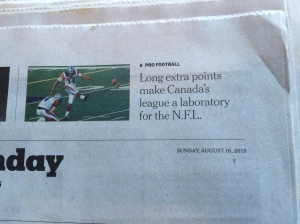Further Ambiguity
Wendy Cope, Making Cocoa for Kingsley Amis (1986)
As with Marilynne Robinson’s Housekeeping, one of the poems in Wendy Cope’s collection confronts us with an ambiguously Canadian reference.
The Poem
The Lavatory Attendant
I counted two and seventy stenches
All well defined and several stinks!
–Coleridge
Slumped on a chair, his body is an S
That wants to be a minus sign.His face is overripe Wensleydale
Going blue at the edges.In overalls of sacerdotal white
He guards a row of fontsWith lids like eye-patches. Snapped shut
They are castanets. All day he hearsShort-lived Niagaras, the clank
And gurgle of canescent cisterns.When evening comes he sluices a thin tide
Across sand-coloured lino,Turns Medusa on her head
And wipes the floor with her. (49)
The Commentary
The flushing toilets make “short-lived Niagaras,” which to a Canadian will immediately raise thoughts of Niagara Falls (Canadian side). But of course there are also falls on the American side, and it is impossible to say whether Cope is thinking of Canada or the U.S. (a problem that has arisen before). Most likely she is just thinking of the humour inherent in comparing a toilet flush to one of the largest waterfalls in the world, and isn’t thinking about Canadian versus American sides at all — such things concern us, not her.
Since the Canadian falls are the larger and more impressive, however, the comparison is inherently funnier if the Canadian falls are meant, because the contrast is greater. And since Cope herself is a British poet, I feel we can draw on our history as a British colony and claim the reference as a Canadian one.
And while it’s an honour for Canada to be home to (the most impressive part of) a waterfall that is so famous poets from other countries draw on it for comparisons, we might note that Canada is, yet again, known for a natural feature that happens to be within our borders rather than for anything that could really be considered a Canadian accomplishment.
The Commentary on The Commentary
The thought process in the second paragraph above reveals a peculiarly Canadian form of insecurity: we’re convinced that the world in general takes no notice of us, and so when we come across a reference that might be about us, but might not, we’re very keen to convince ourselves that it is about us, because it makes us feel important to be referred to by non-Canadians. Being noticed forms a sort of bulwark against our own feelings of national insignificance.
As for the third paragraph, how typical: go to great lengths to claim a reference is Canadian, and then complain that it’s not complimentary enough.

